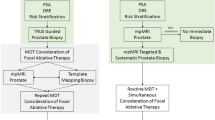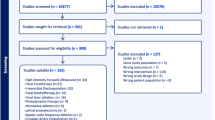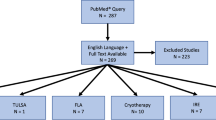Abstract
Focused ultrasound holds promise in a large number of therapeutic applications. It has long been known that high-intensity focused ultrasound (HIFU) can kill tissue through coagulative necrosis. However, it is only in recent years that practical clinical applications are becoming possible, with the development of high-power ultrasound arrays and noninvasive monitoring methods. In the last decade, HIFU have been adapted and used to treat localized prostate cancer and it is now commercially available in Europe. In this article, preclinical studies and clinical development of prostate HIFU as well as early clinical results from our center and international studies are reviewed. Early results demonstrated that prostate HIFU is efficient to obtain local control for low- and intermediate-risk localized prostate cancer; however, long-term follow-up is still needed to estimate the efficacy of prostate HIFU in terms of specific cancer mortality. This makes HIFU a viable alternative in patients not candidate for radical therapy.
This is a preview of subscription content, access via your institution
Access options
Subscribe to this journal
Receive 4 print issues and online access
$259.00 per year
only $64.75 per issue
Buy this article
- Purchase on Springer Link
- Instant access to full article PDF
Prices may be subject to local taxes which are calculated during checkout






Similar content being viewed by others
References
Fessenden P . Ultrasound methods for inducing hyperthermia. Front Radiat Ther Oncol 1984; 18: 62–69.
Fessenden P et al. Experience with a multitransducer ultrasound system for localized hyperthermia of deep tissues. IEEE Trans Biomed Eng 1984; 1: 126–135.
Lele PP, Parker KJ . Temperature distributions in tissues during local hyperthermia by stationary or steered beams of unfocused or focused ultrasound. Br J Cancer Suppl 1982; 45: 108–121.
Sommer FG, Pounds D . Transient cavitation in tissues during ultrasonically induced hyperthermia. Med Phys 1982; 9: 1–3.
ter Haar G, Hand JW . Heating techniques in hyperthermia. III. Ultrasound. Br J Radiol 1981; 54: 459–466.
Hynynen K . Acoustic power calibrations of cylindrical intracavitary ultrasound hyperthermia applicators. Med Phys 1993; 20: 129–134.
Hynynen K, Davis KL . Small cylindrical ultrasound sources for induction of hyperthermia via body cavities or interstitial implants. Int J Hyperthermia 1993; 9: 263–274.
Damianou C, Hynynen K . Focal spacing and near-field heating during pulsed high temperature ultrasound therapy. Ultrasound Med Biol 1993; 19: 777–787.
Chapelon JY et al. In vivo effects of high-intensity ultrasound on prostatic adenocarcinoma Dunning R3327. Cancer Res 1992; 52: 6353–6357.
Gelet A et al. Prostatic tissue destruction by high-intensity focused ultrasound: experimentation on canine prostate. J Endourol 1993; 7: 249–253.
Gelet A et al. High-intensity focused ultrasound experimentation on human benign prostatic hypertrophy. Eur Urol 1993; 23: 44–47.
Uchida T et al. Transrectal high-intensity focused ultrasound for treatment of patients with stage T1b–2n0m0 localized prostate cancer: a preliminary report. Urology 2002; 59: 394–398.
Gelet A et al. Preliminary results of the treatment of 44 patients with localized cancer of the prostate using transrectal focused ultrasound. Prog Urol 1998; 8: 68–77.
Beerlage HP et al. High-intensity focused ultrasound (HIFU) followed after one to two weeks by radical retropubic prostatectomy: results of a prospective study. Prostate 1999; 39: 41–46.
Rouvière O et al. MRI appearance of prostate following transrectal HIFU ablation of localized cancer. Eur Urol 2001; 40: 265–274.
Thuroff S et al. High-intensity focused ultrasound and localized prostate cancer: efficacy results from the European multicentric study. J Endourol 2003; 17: 673–677.
Thuroff S, Chaussy C . High-intensity focused ultrasound: complications and adverse events. Mol Urol 2000; 4: 183–187.
Gelet A et al. Local control of prostate cancer by transrectal high intensity focused ultrasound therapy: preliminary results. J Urol 1999; 161: 156–162.
Author information
Authors and Affiliations
Corresponding author
Additional information
Financial Support: None.
Rights and permissions
About this article
Cite this article
Colombel, M., Gelet, A. Principles and results of high-intensity focused ultrasound for localized prostate cancer. Prostate Cancer Prostatic Dis 7, 289–294 (2004). https://doi.org/10.1038/sj.pcan.4500721
Received:
Revised:
Accepted:
Published:
Issue Date:
DOI: https://doi.org/10.1038/sj.pcan.4500721
Keywords
This article is cited by
-
Transrectal high-intensity focused ultrasound (HIFU) treatment of localized prostate cancer: review of technical incidents and morbidity after 5 years of use
Prostate Cancer and Prostatic Diseases (2010)
-
Transmission electron microscopy of VX2 liver tumors after high-intensity focused ultrasound ablation enhanced with SonoVue®
Advances in Therapy (2009)
-
Influence of the docetaxel administration period (neoadjuvant or concomitant) in relation to HIFU treatment on the growth of Dunning tumors: results of a preliminary study
Prostate Cancer and Prostatic Diseases (2008)
-
Locally ablative therapies for primary radiation failures: A review and critical assessment of the efficacy
Current Urology Reports (2007)
-
Locally ablative therapies for primary radiation failures: A review and critical assessment of the efficacy
Current Prostate Reports (2007)



